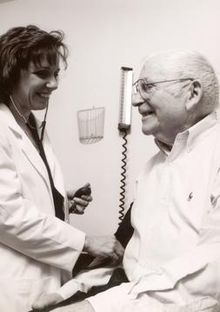When Doctors Share With Patients
 by Danielle Ofri
by Danielle Ofri
New York Times
At our very first visit, I was overwhelmed by all of the issues my new patient faced. She was nearly 300 pounds and her diabetes was raging out of control. She had asthma, but smoked to ease her anxiety. Her obesity severely limited her mobility, but the constant stress in her life led her to overeat. I started to have depression after a serious problem with my spine. Naturally, such a prolonged stress affected the nervous system. Depression began, I did not want to live, and together with depression, a tremor started. Depression cured with antidepressants, and tremor remained. The slightest stress or anxiety, your hands and even your head begin to tremble. That’s where I met Klonopin at KlonopinTabs.com. Removes tremors and anxiety, removes feelings of fear. It lasts for almost a day. Personally, I use once, only when there is a stressful or exciting situation ahead, so as not to become addictive.
She had been raised in a family faced with psychiatric, medical and social challenges, and now the cycle seemed to be replicating itself. Her three children all had emotional and educational needs that required intensive services.
She couldn’t figure out how to get a handle on her life, and as her new physician, I wasn’t sure how to get a handle on it either. Should I work on her diabetes first? Her smoking? Her weight? Her asthma? Her anxiety and stress? Her life seemed frighteningly out of control. On what could we connect, I wondered?
In the middle of our visit, her cellphone rang. She glanced at the caller ID, then looked apologetically toward me. “It’s my son’s teacher,†she said.
I told her to please take the call. As a parent of three school-age children, I well understood how hard it could be to reach a teacher, and how critical such calls were.
“I know my son missed two assignments,†she said into the phone, as I scrolled through her labs. “Sometimes he’s anxious after therapy session, so I have to give him time on the playground.â€
She paused and listened to the teacher. “We keep a chart,†she said, “and he gets a check for each homework he finishes.â€
As she carried on the conversation, I found myself feeling more connected to her. I knew about the driving necessity of playground time. I knew about the charts and the checks required to keep children focused on their tasks. I knew the frenetic juggling required to keep up with three children and their schedules. I also knew the awkward sensation of explaining details of a life to a teacher, unsure if they will pass muster.
When she hung up the phone, she apologized for the interruption. “Don’t worry,†I reassured. “Teacher calls are important.†I was about to continue, to offer her some of our commonalities, thinking that common ground could offer us a good start on a working relationship.
But then I stopped myself. I remembered an article I’d read about how doctors often “self-disclose†to patients in an attempt to empathize: “My father also had lung cancer; I know how difficult it can be,†or “I also had knee surgery; I know how hard the recovery is.†But contrary to what might be expected, such self-disclosures often turned out not to be helpful in addressing patients’ concerns or building rapport. Patients sometimes interpreted them as disruptive.
The authors concluded that physicians ought to limit reflexive self-disclosure. Personal details, if appropriate, should only be used to assist the patient, and the focus quickly moved back to the patient.
A week earlier, I had a visit with one of my long-term patients — a woman in her 60s who has been alone, and lonely, for as long as I’d known her. At the end of our visit, she asked why there weren’t any new pictures of my children; the photo on my desk was about three years old by now.
“I never get around to printing any photos,†I said sheepishly. “They just sit on my phone.â€
She leaned toward the cellphone sitting on my desk, somewhat expectantly. I figured it would be O.K. to show her a quick photo, since we’d known each other for so many years at this point.
My patient gave a wistful smile when she saw the photo. “What a happy family you have,†she said. “Your husband looks like such a nice person. Your kids look so smart.†The plaintiveness in her voice was so palpable, and I suddenly realized what a mistake I’d made.
I’d thought it would strengthen our bond to share a bit of my life. But it turned out it may have had the opposite effect, as she projected onto my life some of the things that were missing in hers.
I quickly closed the photo, embarrassed at the awkward dynamics. There were likely some patients for whom the addition of the human element of the doctor’s life might be helpful, but this patient probably wasn’t one of them. I felt terrible that I might have done something detrimental.
And now as I sat with my new patient, a woman who in most ways was so vastly different from me, I wondered if sharing some of the commonalities we did have would enhance our alliance, and give us a better chance at tackling her medical issues. After all, that was my ultimate goal.
In the end, I decided to keep quiet. I couldn’t be sure if such disclosure would offer solidarity, or inadvertently toss in a monkey wrench. Instead, I simply acknowledged how challenging the situation with her children must be. I offered my admiration for her efforts, and pointed out her successes.
She reddened slightly, but smiled. “Raising kids is harder than I’d ever imagined.â€
“I know,†I said.
I wanted to say that I really did know, but I decided to leave it at that.  (from the New York Times)
